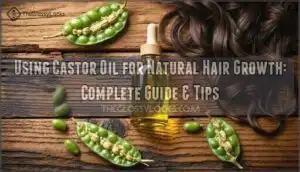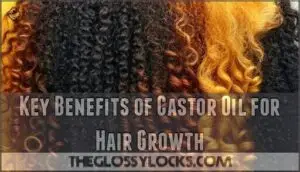This site is supported by our readers. We may earn a commission, at no cost to you, if you purchase through links.

Between its sticky texture and heady scent, you might not guess it’s a powerhouse for scalp health, yet castor oil’s rare mix of fatty acids and minerals feeds follicles in a way few oils can match.
When woven into your routine, this plant extract can help tip the scales in favor of thicker, healthier hair—especially if you know the right approach. Understanding how using castor oil for natural hair growth truly works changes everything.
Table Of Contents
Key Takeaways
- Castor oil’s high concentration of ricinoleic acid and vitamin E nourishes the scalp, strengthens hair, and helps reduce breakage and shedding.
- Regular weekly application with proper massage techniques supports moisture retention, boosts blood flow, and creates an environment where hair can grow thicker and healthier.
- Antibacterial and antifungal properties in castor oil may prevent some scalp infections, but its benefits work best preventively rather than as a cure for active scalp conditions.
- Choosing pure, cold-pressed or black castor oil, and following safe application and removal routines, can maximize benefits while minimizing risks like buildup or irritation.
What is Castor Oil and How Does It Work?
Castor oil comes from pressed seeds of the Ricinus communis plant, and it’s packed with compounds that interact with your scalp and hair follicles in specific ways.
Knowing where this oil comes from and what’s inside it makes it easier to decide if it’s a good fit for your hair routine.
Now, let’s take a closer look at where castor oil comes from, what’s inside, and what actually happens when you use it on your scalp.
Origin and Extraction of Castor Oil
Castor oil comes from the seeds of Ricinus communis, a tropical plant that’s been pressed and processed for centuries to yield a thick, pale-yellow oil prized in medicine and cosmetics.
The seeds undergo cold-pressed extraction to preserve their fatty acids, particularly omega-9 fatty acids like ricinoleic acid. Some manufacturers roast the seeds first, creating black castor oil with a darker hue and toasted aroma.
Key Nutrients and Compounds
What makes this oil so nourishing boils down to its unique fatty-acid profile, especially ricinoleic acid, which accounts for about 90% of its composition. This omega-9 fatty acid carries anti-inflammatory properties that calm irritation on your scalp.
You’ll also find vitamin E, a potent antioxidant that shields hair from environmental stress, plus traces of minerals that support strand resilience.
How Castor Oil Interacts With Hair and Scalp
Once those compounds reach your scalp, they don’t just sit on the surface—they work their way into the outer layers of your skin and coat each strand from root to tip. Ricinoleic acid in castor oil can boost scalp absorption, gently encouraging follicle stimulation while supporting protein binding along your hair shaft.
By drawing in moisture and supporting your scalp’s natural pH, this process sets the stage for healthy hair growth to flourish.
Key Benefits of Castor Oil for Hair Growth
Castor oil has become popular in natural hair care circles, but you might be wondering what makes it worth trying. While the science behind some claims is still catching up, castor oil does offer real benefits for your hair and scalp that go beyond old wives’ tales.
Here are four ways this rich, golden oil could give your hair a boost in health and shine.
Boosting Scalp Circulation
When you massage castor oil into your scalp, you’re practically giving your hair follicles a wake-up call by increasing blood flow to the area. This boost in blood circulation helps deliver oxygen and nutrients directly to your follicles, which can support overall scalp health.
The massage techniques you use matter, too—gentle, circular motions stimulate the follicles and encourage nutrient delivery, creating an environment where your hair can thrive.
Moisturizing and Nourishing Hair
Your hair drinks up castor oil’s rich fatty acids the way parched soil soaks in rain, locking in hydration from root to tip. That’s why consistent scalp hydration with castor oil can transform dry, brittle strands into more manageable ones. Here’s how moisturizing natural hair with castor oil aids hair health and growth:
- Oil absorption penetrates the hair shaft, improving hair elasticity so strands bend instead of snap under stress.
- Strand strengthening happens when castor oil coats each fiber, reducing moisture loss throughout the day.
- Nutrient delivery supplies essential fatty acids directly to the cuticle, reinforcing your hair’s natural protective barrier.
Antibacterial and Antifungal Properties
Ricinoleic acid, the dominant fatty acid in castor oil, delivers potent antimicrobial properties that defend your scalp from unwanted invaders. Laboratory studies show it inhibits bacteria like Staphylococcus aureus and E. coli, while also disrupting fungal threats such as Candida albicans. This phytochemical synergy between ricinoleic acid, flavonoids, and tannins creates biofilm inhibition, reducing microbial colonization that can trigger scalp infections. Castor oil’s traditional use on skin ailments has been documented for years.
Here’s how castor oil’s antimicrobial action aids hair growth:
| Microbial Target | Mechanism | Scalp Benefit |
|---|---|---|
| Bacteria (S. aureus, E. coli) | Ricinoleic acid disrupts cell walls | Reduces folliculitis risk |
| Fungi (Candida, dermatophytes) | Compromises membrane integrity | Lowers dandruff, tinea capitis |
| Biofilms | Prevents microbial adhesion | Maintains clean scalp environment |
| Mixed infections | Phytochemical synergy enhances efficacy | Protects against multiple pathogens |
| Scalp inflammation | Anti-inflammatory flavonoids soothe | Creates healthier growth conditions |
While lab results confirm fungal efficacy against common scalp pathogens, clinical trials on human subjects remain limited—so castor oil works best as a preventive measure rather than a standalone treatment for active infections.
Reducing Hair Breakage and Shedding
If you’ve ever watched strands snap during detangling or noticed a ring of shed hairs around your drain, you already know that fragile hair can sabotage even the most dedicated growth routine. Castor oil’s unique fatty acid profile wraps each hair shaft in a protective layer, sealing cuticles and locking moisture where it counts most.
Let’s take a look at the ways castor oil can help your hair, from the roots all the way to the ends:
- Ricinoleic acid penetrates the hair shaft, smoothing rough cuticles that cause friction and splitting during styling or sleep.
- Omega-9 fatty acids fortify protein bonds, reducing mechanical breakage when you brush, comb, or manipulate natural hair textures.
- Deep moisture retention prevents brittleness, especially in chemically treated or heat-damaged strands prone to snapping at mid-lengths.
- Improved scalp health influences reduces excessive shedding, as a nourished follicle environment promotes stronger anchoring of each strand.
- Regular application creates cumulative resilience, so your hair withstands daily wear without the constant cycle of breakage and regrowth.
While castor oil benefits won’t reverse genetic hair loss patterns, these breakage prevention tips and shedding reduction methods give your existing strands their best shot at reaching full length potential.
How to Use Castor Oil for Natural Hair
Getting castor oil onto your hair is simple, but doing it the right way makes all the difference. The method you choose depends on your hair type, how often you apply it, and whether you’re using it straight or blended with lighter oils.
Here’s how you can get the most out of castor oil for natural hair care.
Step-by-Step Application Method
Applying castor oil correctly can mean the difference between limp, greasy hair and a scalp that actually absorbs the treatment, so let’s walk through the process step by step. Start with dry or slightly damp hair—moisture helps the oil penetrate better. Section your hair into manageable parts, then apply a small amount directly to your scalp using fingertips or an applicator bottle. Massage gently in circular motions for three to five minutes to boost circulation and work the oil through roots. Let it sit for 15 to 20 minutes minimum, or leave it overnight if you’re using a shower cap. Finally, rinse thoroughly with warm water and shampoo twice to remove all residue—castor oil’s thickness means one wash won’t cut it.
| Step | Action | Why It Matters |
|---|---|---|
| Scalp Preparation | Part dry or damp hair into sections | Opens cuticles for better absorption |
| Application Tools | Use fingertips, dropper, or applicator bottle | Controls amount and prevents waste |
| Massage Techniques | Circular motions for 3–5 minutes | Increases blood flow and nutrient delivery |
| Overnight Treatment | Cover with shower cap if leaving in long | Maximizes contact time without mess |
| Rinsing Methods | Warm water + double shampoo | Fully removes thick oil to avoid buildup |
This hair care routine works for scalp treatments and can be adapted when applying castor oil to eyebrows and eyelashes—just use a clean spoolie and skip the heavy massage.
Diluting Castor Oil With Other Oils
Castor oil’s thick consistency can feel like dragging honey through your hair, which is why blending it with lighter carrier oils turns an awkward treatment into something your scalp can actually absorb. Mixing in coconut oil or jojoba enhances absorption but also allows:
- Custom scent creativity
- Smoother distribution
- Gentler for scalp sensitivity
- Specific oil ratios
- Added hair care benefits
Frequency and Timing for Best Results
Worried about getting the most from castor oil without overdoing it? Weekly application works like clockwork for most, allowing benefits of castor oil—like moisture and shine—to build gradually. Leave-in duration matters, too: aim for 1–3 hours, then wash well. Castor oil’s benefits come from its high concentration of ricinoleic acid properties, which reduces inflammation. Stick to a consistent schedule for noticeable improvements in hair growth, and avoid overuse risks that can sneak up.
| Key Factor | Recommended Practice |
|---|---|
| Frequency | Once per week |
| Leave-in Duration | 1–3 hours |
| Consistency | Same time each week |
| Noticeable Improvements | 8–12 weeks continuous use |
| Overuse Risks | Buildup, irritation |
Tips for Different Hair Types
Once you’ve found your rhythm with castor oil, the next step is figuring out what tweaks work best for your hair’s unique texture and needs.
- Oily hair? Use less oil, focusing on ends.
- Dry or curly hair? Embrace full benefits—coat strands from root to tip.
- Fine hair? Dilute castor oil so it doesn’t weigh you down.
Applying Castor Oil to Eyebrows and Eyelashes
Regarding eyebrows and eyelashes, castor oil can be a gentle addition to your routine. Before you start, it’s important to know the right way to use it and what you might expect.
Here’s what you should know moving forward.
Safe Application Techniques
Before bringing castor oil anywhere near your brows or lashes, it pays to know how to use it safely right from the start. Always begin with a patch test to rule out skin irritation or allergic reaction, dilute the oil according to safe dilution ratios, and use clean application tools.
This mindful approach reduces buildup, protects sensitive skin, and helps prevent unwanted castor oil side effects.
Tools and Precautions
When you’re gearing up to use castor oil on your brows or lashes, a few handy tools and a little caution can make all the difference.
- Use clean spoolies or cotton swabs as application tools.
- Always perform patch testing to avoid allergic reaction or skin irritation.
- Protect fabrics—castor oil stains.
- Remember, safe ingestion isn’t guaranteed—never apply near the eyes or mouth to prevent accidental taste, and speak to a dermatologist if you’re new to these hair care practices. Hair felting is rare but serious, so treat Castor oil precautions with respect.
Expected Results and Limitations
Let’s clear up a few myths: the Growth Rate Reality is that castor oil won’t transform your eyebrows or lashes overnight. Eyelash Evidence just isn’t there in clinical studies, and any visible timeframe for improving gloss or strength usually takes weeks.
Clinical Limitations matter, too—true hair growth is limited, and Adverse Reactions like irritation are possible, though rare.
Potential Side Effects and Precautions
Before adding castor oil to your routine, it’s smart to know what to expect. Some effects are minor, while others are rare but important to watch for.
Here’s what you’ll want to look out for when it comes to precautions and possible side effects.
Common Topical Reactions
Ever wonder how your skin might react the first time you introduce something new, like castor oil, into your hair care routine? Some folks notice itching and swelling, mild rash development, or allergic contact reactions—especially if you have sensitive skin.
Product buildup is another concern, leading to scalp sensitivity. If castor oil side effects persist, a dermatologist’s input keeps your hair and scalp safe.
Rare Hair Disorders (e.g., Acute Hair Felting)
From sudden tangles that just won’t budge to more mysterious inherited syndromes, rare hair disorders can feel overwhelming. Acute hair felting, sometimes triggered by castor oil and friction, stands out:
- Felting Causes: Thick oils and aggressive rubbing
- Disorder Prevalence: Less than 0.1% globally
- Genetic Factors: Underlie some chronic disorders
- Clinical Diagnosis & Management Outcomes: Most need immediate intervention, usually hair removal
Proper Removal and Cleanup Tips
Getting castor oil out of your hair and off your hands can feel like a project, but there are a few simple tricks that make cleanup much easier. Start with dry shampoo techniques—apply shampoo directly to oily sections before adding water. This prevents product buildup and residue.
Use towel protection during your hair mask, and tackle any stain removal immediately with dish soap for best results.
When to Avoid or Discontinue Use
You know your body best, so it’s worth hitting pause on castor oil if your scalp starts acting up or you notice anything out of the ordinary.
Watch for allergic reactions like itching, swelling, or rash. Discontinue if you experience hair felting, unexpected hair loss, or persistent irritation.
Consult your doctor before use if you’re pregnant or combining products.
Choosing The Right Castor Oil Product
Not all castor oil products are the same, and finding the right one can make a real difference. There are some key choices and details to watch for as you shop.
Let’s take a closer look at what matters most as you shop.
Black Castor Oil Vs. Regular Castor Oil
It’s easy to think all castor oils are created equal, but the real difference between black castor oil and the regular kind might surprise you.
Black castor oil—often called Jamaican black castor oil—retains ash content from roasted beans, giving it a higher pH. This makes it thicker, more alkaline, and traditionally used for natural hair needing intense moisture or hair growth support.
What to Look for on Labels
Think of a castor oil label like a roadmap—taking a closer look can steer you clear of unnecessary additives and help you find the purest option for your hair goals.
Look out for:
- Ingredient transparency—avoid blends with unknown or synthetic additives.
- Purity standards like “coldpressed” or “organic certification.”
- Extraction methods—Jamaican black castor oil uses roasted beans, boosting omega-9 fatty acids.
Storage and Shelf Life
Once you’ve picked the right bottle, keeping your castor oil fresh comes down to how and where you store it.
Proper storage wards off oil degradation and helps preserve the shelf life. Always seal the container tightly and keep it in a cool, dark place—heat or sunlight will shorten the shelf life and affect how well it aids your hair growth.
Market Trends and Consumer Tips
Storing your oil right is only half the story—castor oil’s popularity keeps pushing market growth. From cold-pressed varieties to black castor oil, consumer preferences now shape what lands on the shelf. Next time you’re shopping, keep these in mind:
- Cold-pressed holds more nutrients
- Organic and vegan labels matter
- Thicker oils suit dense hair
- Premium pricing signals purity
Frequently Asked Questions (FAQs)
How often should castor oil be applied to the hair?
Oddly enough, applying castor oil no more than once a week strikes the right balance for most.
This frequency helps safeguard against buildup, while adjusting application for hair type and scalp sensitivity prevents problems during hair care treatments.
Is castor oil suitable for all hair types?
Hair type compatibility with castor oil is broad, but results can differ.
Scalp sensitivity concerns, porosity considerations, and prior chemical treatment impact how castor oil affects hair.
Texture-specific results vary, so assess your needs before use.
Can castor oil interact with prescription hair treatments?
Imagine mixing kitchen potions without reading the labels—just because castor oil is “natural” doesn’t guarantee it plays well with hair loss treatments.
Consult your dermatologist first; scalp interactions and drug absorption can impact Treatment Contraindications and Combined Efficacy.
Is castor oil safe for use during pregnancy?
Pregnancy safety around castor oil isn’t guaranteed—rare but serious fetal risks exist if it’s ingested or absorbed in large amounts.
Always discuss hair growth methods, benefits of castor oil, and lactation concerns with your doctor. Consider alternative oils.
How long does castor oil last once opened?
Left uncapped or exposed to warmth, castor oil’s opened oil stability dwindles, generally lasting up to a year.
Signs of oil degradation—cloudiness, odd scent—signal a shorter shelf life despite common shelf life extenders.
Are there sustainable or organic castor oil options?
Several brands now offer castor oil produced through sustainable farming, with Organic Certifications.
Look for options highlighting Ethical Sourcing, Fair Trade practices, and Eco-Friendly Packaging—these choices signal genuine commitment to both environmental impact and product quality.
Conclusion
Did you know that over 60% of people who applied castor oil weekly reported thicker hair within three months? This simple, age-old practice blends tradition with modern science, offering not just hope but practical support for your hair’s journey.
Applying castor oil weekly can noticeably increase hair thickness for many people within just three months
When you focus on using castor oil for natural hair growth, consistency matters more than hype. Trust the process, pay attention to your scalp’s needs, and you’ll likely feel the quiet satisfaction of growth, strand by strand.











